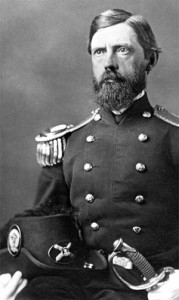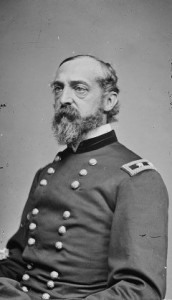Gettysburg Live 150 – 11:00am – Buford Arrives at Gettysburg
150 years ago right now, Union Brig. General John Buford’s 1st Cavalry Division arrives in Gettysburg.
The folks in town are very happy to see him. Only a few minutes before, a Confederate scouting force – a brigade of infantry under the command of Brig. General J. Johnston Pettigrew – came near the town in search of supplies. He is told that they moved to the west along the Chambersburg Pike, toward Cashtown – back the way they came. Buford decides to go have a look.
Pettigrew left in a hurry because he saw the Union cavalry coming. His orders were to scout, not to start a battle, so he decided to go back to headquarters to let his superiors, Maj. General Henry Heth and Lt. General A.P. Hill, know what was going on. The Union army was north of the Potomac, and closing in on the rebels.
Neither Heth nor Hill believed Pettigrew’s story. You see, Pettigrew was not a West Point-trained, professional soldier like they were; he was a college professor from North Carolina who had spent most of the war in coastal defense duties, not in battle. How could he know the difference between the Army of the Potomac and the inexperienced local militia that General Early’s men had brushed aside a few days before? These had to be those same troops back for more punishment. Heth, new to his division command and looking to gather glory to his name, asked for and received permission from A.P. Hill to take his full division to Gettysburg the next day to rough-up these home guards.
By mid-afternoon, General Buford had a feeling that Pettigrew’s “retreat” was not for real. Though his subordinates disagreed, Buford knew the rebels would be back in force. Gettysburg had a superb road network, and good high ground all around the town. If a battle was to be fought, this would be a good place to do it. Buford wanted to retain control of this excellent position, so he dug in for a defense. He sent word of his plan to General Reynolds, commanding the western sector of the advance, in the hope that he could bring the 3 corps of infantry that were with him down in Emmitsburg, up to Gettysburg by morning.

